.
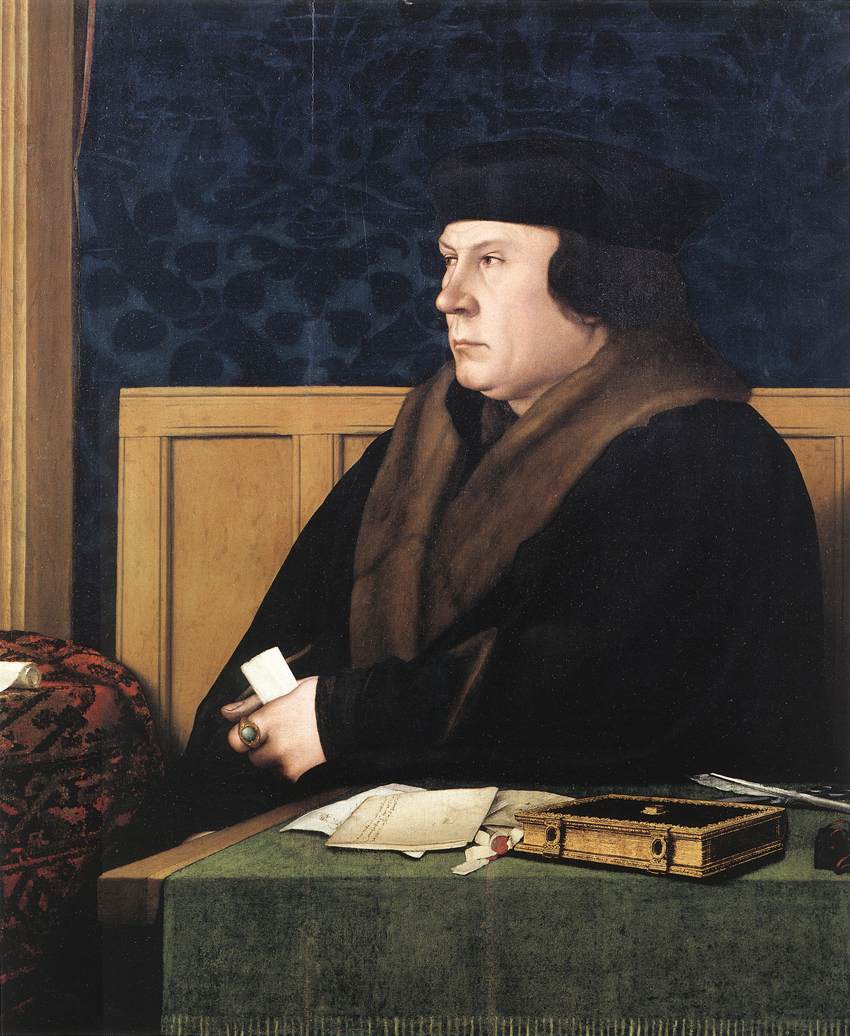
Portrait of Thomas Cromwell: Hans Holbein the Younger, c. 1533, oil on oak, 70 x 61 cm (Frick Collection, New York)
Thomas Wyatt: Stond who so List
Stond who so list vpon the Slipper toppe
...Of courtes estates and lett me heare rejoyce
And vse me quyet without lett or stoppe
...Vnknowen in courte that hath suche brackishe ioyes
.....In hidden place so lett my dayes forthe passe
...That when my yeares be done withouten noyse
.....I may dye aged after the common trace
Ffor him death greepthe right hard by the croppe
...That is moche knowen of other and of him self alas
...Doth dye unknowen dazed with dreadfull face
Thomas Wyatt (1503-1542): Stond who so list vpon the Slipper toppe, c. 1540 (text from Arundel Harington ms.)
1 Slipper = slippery. Cf. Wyatt's translation of Plutarch, Quyet of Mind: "slypper riches".
1 toppe (culmine). Cf. Sir T. Elyot's version of the Seneca chorus.
3 use...stop. i.e., Comport myself quietly without hindrance of impediment from others [R. Rebholz].
4 Vnknowen in courte (nullis nota Quiritibus). Cf. Elyot: "Myyde unknowen".
4 that hathe suche brackish ioyes [Wyatt's addition to the Latin].
4 brackishe: being spoiled to the point of being nauseous by the mixture of the salty with the fresh [Rebholz].
6 withouten noyse (per tacitum): Elyot.
7 after the common trace: (1) a common way or path; (2) like other people. The Latin has "a common man" (plebeius) [Rebholz].
8 dazed with dreadfull face [Wyatt's addition].
8 dazed: (1) bewildered, stupefied (2) benumbed with cold.
8 croppe (crop): (1) bird's neck; (2) throat.
8 death...croppe: Latin has "Death lies heavy on him" (illi mors gravis incubat).
10 unknowen (ignotus): Elyot.

Jean de Dinteville and Georges de Selve (The Ambassadors): Hans Holbein the Younger, 1533, oil on wood, 207 x 209 cm (National Gallery, London)
In [Wyatt's] finest imitations... historical consciousness goes... further. Imitation becomes fully heuristic and frequently dialectical; it takes the full responsibility for its cultural moment and location, "in Kent and Christendome," with the vulnerabiity as well as the strength these involve. To demonstrate this degree of consciousness, one need only cite the superb little version of Seneca, doubtless written after the execution of Wyatt's patron [Thomas] Cromwell [in 1540]... this derives from a chorus of Seneca's Thyestes... Wyatt Englishes this by suppressing the Latin leni... otio, the easy leisure that calls up an aristocratic Roman villa. Wyatt's language identifies him as an Anglo-Saxon countryman whose quietude will not be voluptuous, and whose death will not simply go unremarked, nullo cum strepitu, but whose obscurity will adhere to the traditional manner of ordinary folk, "after the common trace". "Trace" is itself one of those rustic words that help to situate the speaker. Wyatt omits the hint of sensual satisfaction in Seneca's saturet, adds the powerful modifier "brackishe" (salty, nauseating) in his fourth line, plays the force of "rejoyce" against the sobriety of "quyet", with its echo of the poet's translation of Plutarch, The Quyet of Mynde. Above all, Wyatt rewrites the closing lines, roughening Seneca's neat antithesis in ll. 12-13 and suppressing his sinister image of suffocation (incubat -- settles down upon, broods upon like a bird) for the more violent clutch of Death's abrupt hand: "him death greep'the right hard by the croppe." The five stressed monosyllables in unbroken sequence violate the rhythmic pattern with a wrench that corresponds to the action, and the harsh Anglo-Saxon words maintain the identity of a speaker hidden in the countryside outside a Latinate court. The control of verse movement, expert throughout, culminates in the majestic rallentando of the last line and a half, its terrible subsiding intensified by the pitiless alliteration. Brilliantly, Wyatt chooses not to explain why the lack of knowledge renders death's grip so much harder, nor to explain the brilliant concluding phrase, his own addition -- "dazed with dreadfull face". The great man is "dazed" -- stupefied, bewildered, numbed -- because death's assault has been so sudden, because its numbing physiological effect has already begun or is completed, because we can assume the dying man has fallen from the slipper top of eminence, and perhaps because in his naive egoism he had thought of himself as immune from mortality. He is "dreadfull" -- inspiring reverence, awe, fear-- because as a power at court he has always inspired those, because he is suffering the humiliation of death after so much sway, because conceivably he has been publicly executed like Cromwell, and because, most profoundly, he is suffering this death in the limelight without the redeeming possession or acquisition of self-knowledge; he remains "of him self... unknowen." Wyatt's use of the Latin chorus only serves to help him find an idiom that is radically anti-Latinate and calls attention to its own parochial rusticity; his use of the somewhat facile Stoic morality helps him to adumbrate a drama of his own time and place, By insisting on its English provincialism the text assumes a vulnerability toward the elegant classicism of its subtext, and only by accepting this vulnerability can it implicitly criticize the subtext's facility. This is an intensely Tudor poem and conscious of itself as such, awake to the dialectical distinctions it has created. By achieving this degree of control over potential anachronism, Wyatt made it possible for the first time to speak of mature English imitation.
Thomas M. Greene, from The Light in Troy: Imitation and Discovery in Renaissance Poetry, 1982

Unknown Gentleman with Music Books and Lute: Hans Holbein the Younger, c. 1534, oil on wood, 43.5 x 43.5 cm (Staatliche Museum, Berlin)
Seneca: from Thyestes
Thomas Wyatt (1503-1542): Stond who so list vpon the Slipper toppe, c. 1540 (text from Arundel Harington ms.)
1 Slipper = slippery. Cf. Wyatt's translation of Plutarch, Quyet of Mind: "slypper riches".
1 toppe (culmine). Cf. Sir T. Elyot's version of the Seneca chorus.
3 use...stop. i.e., Comport myself quietly without hindrance of impediment from others [R. Rebholz].
4 Vnknowen in courte (nullis nota Quiritibus). Cf. Elyot: "Myyde unknowen".
4 that hathe suche brackish ioyes [Wyatt's addition to the Latin].
4 brackishe: being spoiled to the point of being nauseous by the mixture of the salty with the fresh [Rebholz].
6 withouten noyse (per tacitum): Elyot.
7 after the common trace: (1) a common way or path; (2) like other people. The Latin has "a common man" (plebeius) [Rebholz].
8 dazed with dreadfull face [Wyatt's addition].
8 dazed: (1) bewildered, stupefied (2) benumbed with cold.
8 croppe (crop): (1) bird's neck; (2) throat.
8 death...croppe: Latin has "Death lies heavy on him" (illi mors gravis incubat).
10 unknowen (ignotus): Elyot.

Jean de Dinteville and Georges de Selve (The Ambassadors): Hans Holbein the Younger, 1533, oil on wood, 207 x 209 cm (National Gallery, London)
In [Wyatt's] finest imitations... historical consciousness goes... further. Imitation becomes fully heuristic and frequently dialectical; it takes the full responsibility for its cultural moment and location, "in Kent and Christendome," with the vulnerabiity as well as the strength these involve. To demonstrate this degree of consciousness, one need only cite the superb little version of Seneca, doubtless written after the execution of Wyatt's patron [Thomas] Cromwell [in 1540]... this derives from a chorus of Seneca's Thyestes... Wyatt Englishes this by suppressing the Latin leni... otio, the easy leisure that calls up an aristocratic Roman villa. Wyatt's language identifies him as an Anglo-Saxon countryman whose quietude will not be voluptuous, and whose death will not simply go unremarked, nullo cum strepitu, but whose obscurity will adhere to the traditional manner of ordinary folk, "after the common trace". "Trace" is itself one of those rustic words that help to situate the speaker. Wyatt omits the hint of sensual satisfaction in Seneca's saturet, adds the powerful modifier "brackishe" (salty, nauseating) in his fourth line, plays the force of "rejoyce" against the sobriety of "quyet", with its echo of the poet's translation of Plutarch, The Quyet of Mynde. Above all, Wyatt rewrites the closing lines, roughening Seneca's neat antithesis in ll. 12-13 and suppressing his sinister image of suffocation (incubat -- settles down upon, broods upon like a bird) for the more violent clutch of Death's abrupt hand: "him death greep'the right hard by the croppe." The five stressed monosyllables in unbroken sequence violate the rhythmic pattern with a wrench that corresponds to the action, and the harsh Anglo-Saxon words maintain the identity of a speaker hidden in the countryside outside a Latinate court. The control of verse movement, expert throughout, culminates in the majestic rallentando of the last line and a half, its terrible subsiding intensified by the pitiless alliteration. Brilliantly, Wyatt chooses not to explain why the lack of knowledge renders death's grip so much harder, nor to explain the brilliant concluding phrase, his own addition -- "dazed with dreadfull face". The great man is "dazed" -- stupefied, bewildered, numbed -- because death's assault has been so sudden, because its numbing physiological effect has already begun or is completed, because we can assume the dying man has fallen from the slipper top of eminence, and perhaps because in his naive egoism he had thought of himself as immune from mortality. He is "dreadfull" -- inspiring reverence, awe, fear-- because as a power at court he has always inspired those, because he is suffering the humiliation of death after so much sway, because conceivably he has been publicly executed like Cromwell, and because, most profoundly, he is suffering this death in the limelight without the redeeming possession or acquisition of self-knowledge; he remains "of him self... unknowen." Wyatt's use of the Latin chorus only serves to help him find an idiom that is radically anti-Latinate and calls attention to its own parochial rusticity; his use of the somewhat facile Stoic morality helps him to adumbrate a drama of his own time and place, By insisting on its English provincialism the text assumes a vulnerability toward the elegant classicism of its subtext, and only by accepting this vulnerability can it implicitly criticize the subtext's facility. This is an intensely Tudor poem and conscious of itself as such, awake to the dialectical distinctions it has created. By achieving this degree of control over potential anachronism, Wyatt made it possible for the first time to speak of mature English imitation.
Thomas M. Greene, from The Light in Troy: Imitation and Discovery in Renaissance Poetry, 1982

Unknown Gentleman with Music Books and Lute: Hans Holbein the Younger, c. 1534, oil on wood, 43.5 x 43.5 cm (Staatliche Museum, Berlin)
Seneca: from Thyestes
Stet quicumque volet potens
aulae culmine lubrico:
me dulcis saturet quies.
obscuro positus loco
leni perfruar otio,
nullis nota Quiritibus
aetas per tacitum fluat.
sic cum transierint mei
nullo cum strepitu dies,
plebeius moriar senex.
illi mors gravis incubat
qui, notus nimis omnibus,
ignotus moritur sibi.
Lucius Annaeus Seneca (c 4 BC-AD 65), Thyestes, ll. 391-403

Portrait of Henry Howard, the Earl of Surrey: Hans Holbein the Younger, 1541-44, oil on wood, 55.5 x 44 cm (Museo de Arte de Sao Paolo)
Andrew Marvell: The Second Chorus from Seneca's Tragedy, Thyestes
Stet quicunque volet potens
Aulae culmine lubrico etc.
Aulae culmine lubrico etc.
TRANSLATION
Climb at Court for me that will
Tottering Favour's slipp'ry hill.
All I seek is to lye still.
Settled in some secret Nest
In calm Leisure let me rest;
And far off the publick Stage
Pass away my silent Age.
Thus when without noise, unknown,
I have liv'd out all my span,
I shall dye, without a groan,
An old honest Country man.
Who expos'd to others Eyes,
Into his own Heart ne'r pry's,
Death to him's a Strange surprise.
Andrew Marvell (1621-1678): The Second Chorus from Seneca's Tragedy, Thyestes (probably composed after 1668; published posthumously, 1678)
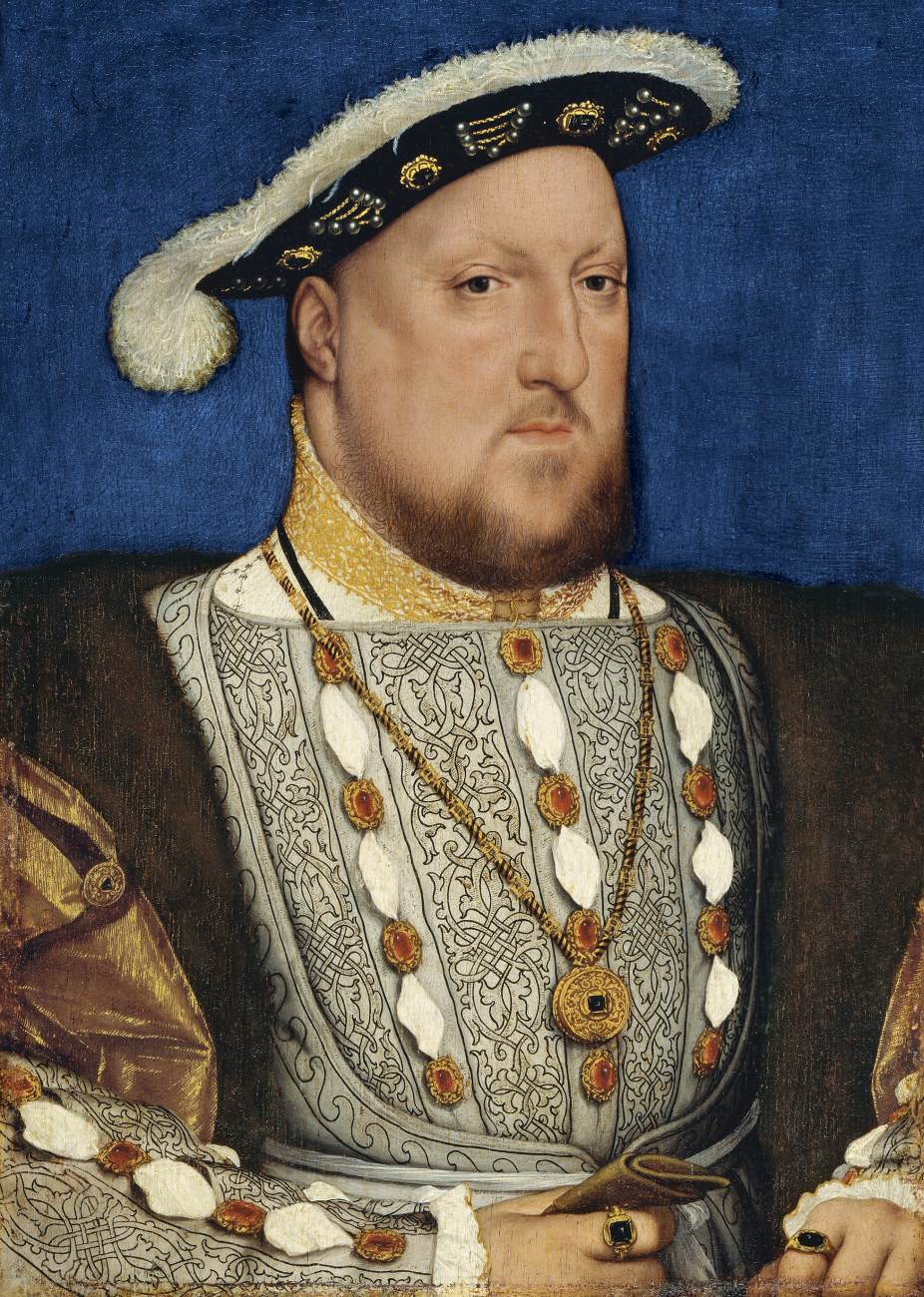
Portrait of Henry VIII: Hans Holbein the Younger, 1533, oil on wood, 207 x 209 cm (National Gallery, London)
John Norris: The Choice (after Seneca)
John Norris (1657-1711): The Choice (after Seneca)
Tottering Favour's slipp'ry hill.
All I seek is to lye still.
Settled in some secret Nest
In calm Leisure let me rest;
And far off the publick Stage
Pass away my silent Age.
Thus when without noise, unknown,
I have liv'd out all my span,
I shall dye, without a groan,
An old honest Country man.
Who expos'd to others Eyes,
Into his own Heart ne'r pry's,
Death to him's a Strange surprise.
Andrew Marvell (1621-1678): The Second Chorus from Seneca's Tragedy, Thyestes (probably composed after 1668; published posthumously, 1678)

Portrait of Henry VIII: Hans Holbein the Younger, 1533, oil on wood, 207 x 209 cm (National Gallery, London)
John Norris: The Choice (after Seneca)
No, I shan't envy him who're he be
That stands upon the Battlements of State;
....Stand there who will for me,
....I'd rather be secure than great.
Of being so high the pleasure is but small,
But long the Ruin, if I chance to fall.
Let me in some sweet shade serenely lye,
Happy in leisure and obscurity;
....Whilst others place their joys
....In Popularity and noise.
Let my soft moments glide obscurely on
Like subterraneous streams, unheard, unknown.
Thus when my days are all in silence past,
A good plain Country-man I'll dye at last;
....Death cannot chuse but be
....To him a mighty misery,
Who to the World was popularly known,
And dies a Stranger to himself alone.
John Norris (1657-1711): The Choice (after Seneca)
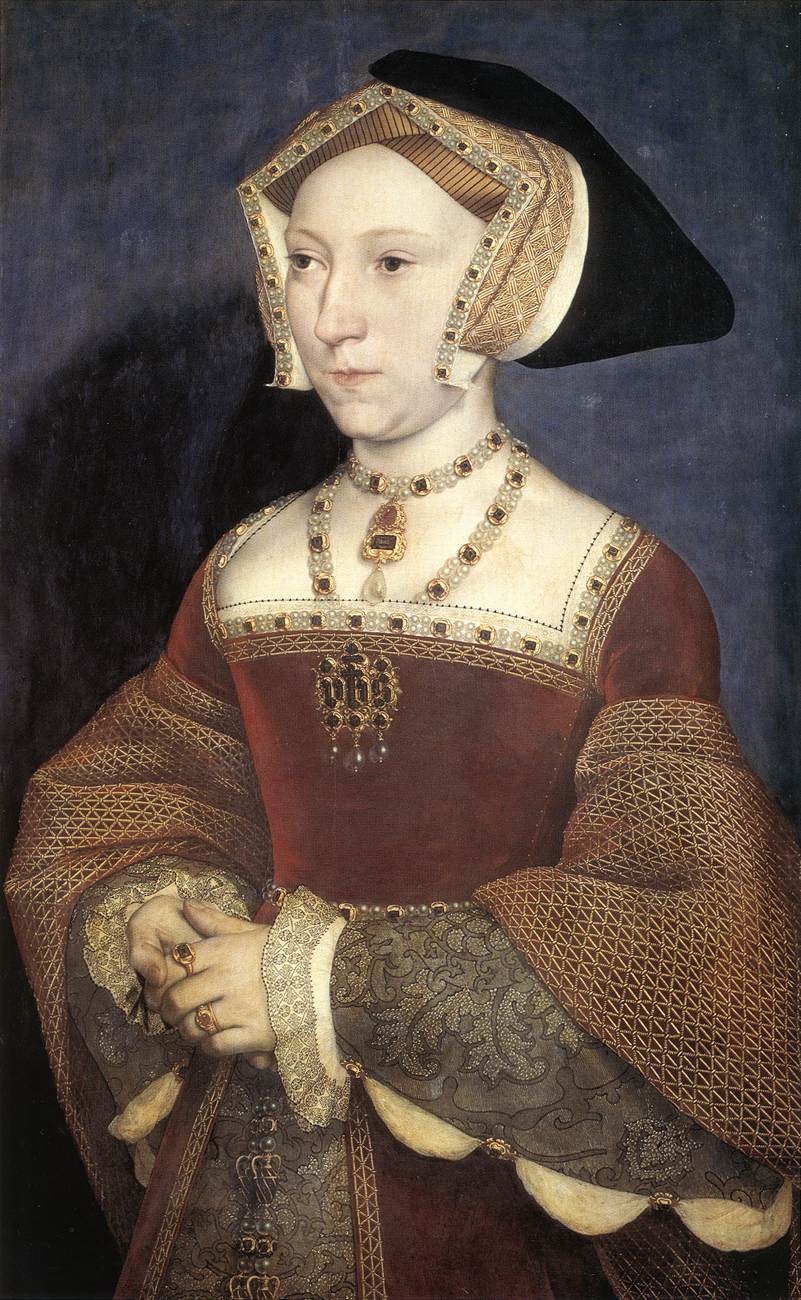
Jane Seymour, Queen of England: Hans Holbein the Younger, 1536, oil on wood, 65.5 x 45 cm (Kunsthistorisches Museum, Vienna)
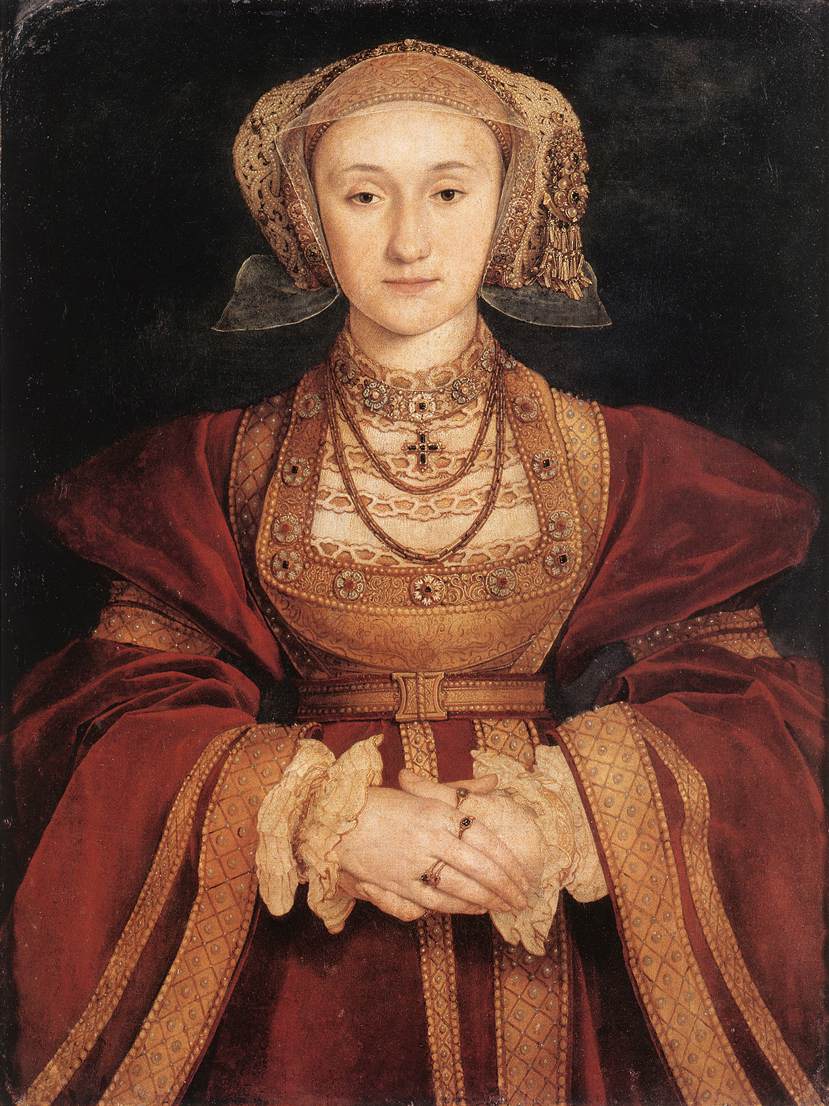
Portrait of Anne of Cleves: Hans Holbein the Younger, c. 1539, parchment mounted on canvas, 65 x 48 cm (Musee du Louvre, Paris)
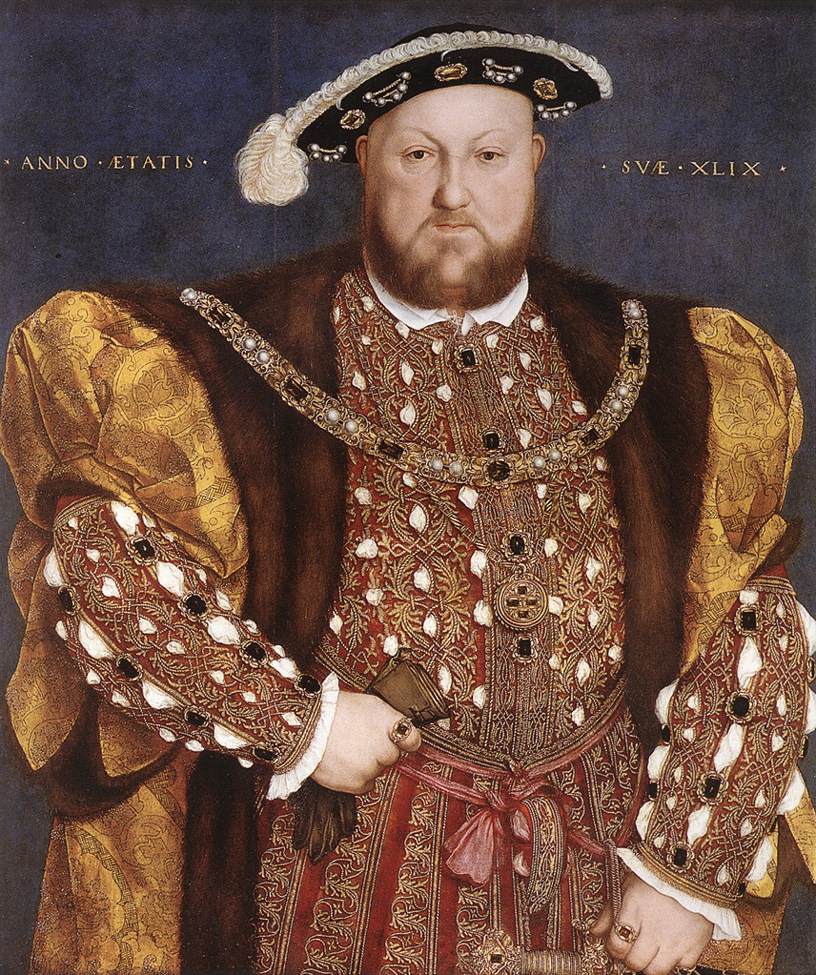
Portrait of Henry VIII: Hans Holbein the Younger, 1540, oil on panel, 88.5 x 74.5 cm (Galleria Nazionale d'Arte Antica, Rome)

Portrait of Catherine Howard: Hans Holbein the Younger, 1540-41, oil on wood, 74 x 51 cm (Toledo Museum of Art, Ohio)

Christina of Denmark, Duchess of Milan: Hans Holbein the Younger, 1538, oil on wood, 179 x 83 cm (National Gallery, London)

Thomas Howard, Duke of Norfolk: Hans Holbein the Younger, 1539-40, oil on wood, 80.3 x 61.6 cm (Royal Collection, Windsor)

Sir Thomas Wyatt: Hans Holbein, c. 1540, oil on panel, 36.7 cm diameter (National Portrait Gallery, London)

Portrait of Margaret Wyatt, Lady Lee [sister of the poet Thomas Wyatt]: Hans Holbein the Younger, c. 1540, oil on wood, 43.5 x 32.7 cm (Metropolitan Museum of Art, New York)

Portrait of Sir Richard Southwell: Hans Holbein the Younger, c. 1537; black and coloured chalks, brush in black and metal pen, 36.6 x 27.7 cm (Royal Collection, Windsor)

Sir Thomas Elyot: Hans Holbein the Younger, 1532-33; chalk, pen and brush on paper, 28.6 x 20.6 cm (Royal Collection, Windsor)

Jane Seymour: Hans Holbein the Younger, 1536-37; black and coloured chalks on paper, 50 x 28.5 cm (Royal Collection, London)

Sir Thomas More: Hans Holbein the Younger, 1527-28; black and coloured chalks on paper, 397 x 299 mm (Royal Collection, London)

Study for the Family Portrait of Sir Thomas More: Hans Holbein the Younger, c. 1527; pen and brush in black on top of chalk sketch, 38.9 x 52.4 cm (Kupferstichkabinett, Öffentliche Kunstsammlung, Basel)
Tom,
ReplyDeleteStond who so list vpon the Slipper toppe
...Of courtes estates
These lines have been embedded in the mind for years now -- wonderful to see them here next to pictures of all these players who listed to stand thereupon.
1.26
light coming into fog against invisible
top of ridge, towhee calling from field
in foreground, sound of wave in channel
initial “against background,”
semicircular place in
structure in whose place it
is, figure, set forth
silver of sunlight reflected in channel,
white cloud in pale blue sky on horizon
Steve,
ReplyDeleteA sliver of sunlight, here, too -- when you said that.
We who are about to admit our common incurable quietude salute the unfolding (or perhaps it's merely folding, like the tents of a circus that has left for the season) of the historical
structure in whose place it
is, figure, set forth
I'm memorizing another Wyatt poem this week (I've set myself the task of memorizing and illustrating a poem a week for 2013). It's actually next week's poem, but I got excited and started early. I've uploaded a panel of the work-in-progress, which you can see here.
ReplyDeleteEek! Mine en'my alas!
ReplyDeleteGlug!
Man the houseboats!
(That's a brilliant project, Nora, we love it.)
Vnknowen in courte that hath suche brackishe ioyes
ReplyDeletebrackishe - at once preservative and poison. Dialectical is about right.
Wyatt's "slipper toppe" and Marvell: "Tottering Favour's slipp'ry hill". Would Marvell be referencing Wyatt directly here? Whether or not, I love the echo.
You're right, TC. Nora's project does look brilliant.
I've now added a Holbein portrait of the poet Wyatt, just above the portrait of his younger sister Margaret, Lady Lee. Both were members of the privileged, sometimes seemingly charmed, often extremely fraught inner circle of the Tudor Court of the period.
ReplyDeleteIt's evident the remarkably honest and observant eye of Holbein saw, and caught, the family resemblance.
Margaret married Sir Anthony Lee, another member of the circle and an amateur poet also, though hardly of Wyatt's calibre.
Within this circle Wyatt's poems -- with those of others, including Lee and Henry Howard, Earl of Surrey, the period's most interesting poet after Wyatt -- were exchanged in the commonplace books in which certain of the ladies of the court inscribed their favourite verses.
(As some of the poems contained admissions and implications that might have been thought dangerously compromising if viewed by the wrong eyes, these books were kept closely, lending this form of private circulation a certain samizdat-like quality.)
The text of the Wyatt poem here given follows a transcription of a transcription -- by Richard Harrier, in The Canon of Sir Thomas Wyatt's poetry, 1975, transcribing the work of a copyist in the Arundel Harington ms.
That ms. itself was not made publicly available until Ruth Hughey's two-volume edition of 1960.
A variant of Wyatt's poem, perhaps representing a different stage of composition, appeared posthumously in Tottel's Miscellany, 1557, under the title "Of the meane and sure estate".
But the long sleep that overtook Wyatt's work from his death until the early 19th century (the first edition of his poems was that compiled by the great antiquarian scholar George Nott, 1815-16) surely shielded it from the view of poets of the intervening times, like Marvell and Norris.
Still there remains, as WB reminds, that nagging apparent coincidence of the repetition of Wyatt's "Slipper" -- present also in the Tottel's version, which begins "Stand whoso list upon the slipper wheel/ Of high estate..." -- in Marvell's "slipp'ry hill".
The Marvell also has interesting variants. One of these begins "Climb at Court for me that will/Giddy Favour's slipp'ry hill".
It appears Marvell wanted to emphasize that the slippery slope of Power is made further problematic to navigate when under the influence -- "tott'ring" gets that.
In short then it seems likely both Wyatt and Marvell were independently developing "slipperiness" out of Seneca's lubrico:
Stet quicumque volet potens
aulae culmine lubrico
The philosopher-poet Norris meanwhile steers clear of the slippery slope figure altogether by turning the slick surface of Ambitious Statecraft into Battlements.
(Norris by the way is an interesting fellow -- "the second-best poet of Bemerton" as he has been called; not such faint praise really when one remembers that the better one was George Herbert.)